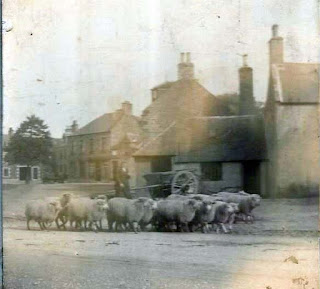The Statistical Account of Scotland for 1791 in the chapter on Earlston gives us an early description of farming around the village.
The account also noted that two fairs were held in Earlston - on the 28th June for sheep, black cattle and horses, reckoned to be "the second best fair in the south of Scotland". The other fair was held on the third Thursday of October."The farmers rear a considerable number of black cattle...which they fatten on turnips. The most common crops in this parish are oats, barley and peas. There is also some wheat. The oats that grow on the grounds at Fans are much esteemed. There is now a greet quantity of clover and of rye grass sown."
Hiring Fairs, held in the Market Square, were important events where men and women farm workers, (ag. labs (agricul.tural labourers), hinds*, shepherds, dairy maids domestic servants etc.) would gather to bargain with prospective farmers for work, and hopefully secure a position for the following 6-12 months.
*The Scottish National Dictionary defines a "hind" in Southern Scotland and Northumberland as "a married skilled farm worker who occupies a cottage on the
farm and is granted certain perquisites in addition to wages.
Hiring Fairs were also social occasions with a rare opportunity for friends and family to meet and enjoy side shows and stalls - as can be seen in the two photographs featured. .
 |
| Hiring Fair in the 1930's. |
*********
Bondagers
were female farm workers in south east Scotland and Northumberland.
As part of their husband's contract (or bond) with the farmer, he would
undertake to provide another worker (usually his wife) to help as and
when required. The women wore a distinctive dress with bonnet, described as
the "last remaining peasant costume" in Britain.
************
"Horses are absolutely necessary in this part of the country, for it is by them the farmers labour their farms and drive their corn to market. They never work with oxen now as they did formerly." - a quote from the 1791 Statistical Account.
Oxen feature in this old photograph which is described as on the "Road between Earlston and Melrose".
Anyone
tracing their family history may well have a "carter or carrier " in
their ancestry - an essential occupation in transporting farmers' goods around.
 |
| A heavily laden cart on Station Road. |
************
 |
| Sheep outside the Smiddy on Station Road - on the way to the Auction Mart by the railway? |
 |
| Sheep Shearing |
***********
 |
| Note the woman helping with the hay-making |
 | |||||||
| Building a Haystack at Cowdenknowes |
 |
| Earlston from Craigsford Mains |
****************
Thank you to everyone who has donated or loaned old photographs for scanning.
Auld Earlston welcomes all contributions on the village's past - contact us on auldearlston@aol.com or via the comments box below.






Excellent selection of photographs with background information.
ReplyDeletemy grandfather who was named Bob Scott worked sorrowless field and cowdeknows farm from when I was a small child in the 60s lots of great memories of owner miss burns but no photos of her or grandparents house in sorrowless field
ReplyDelete